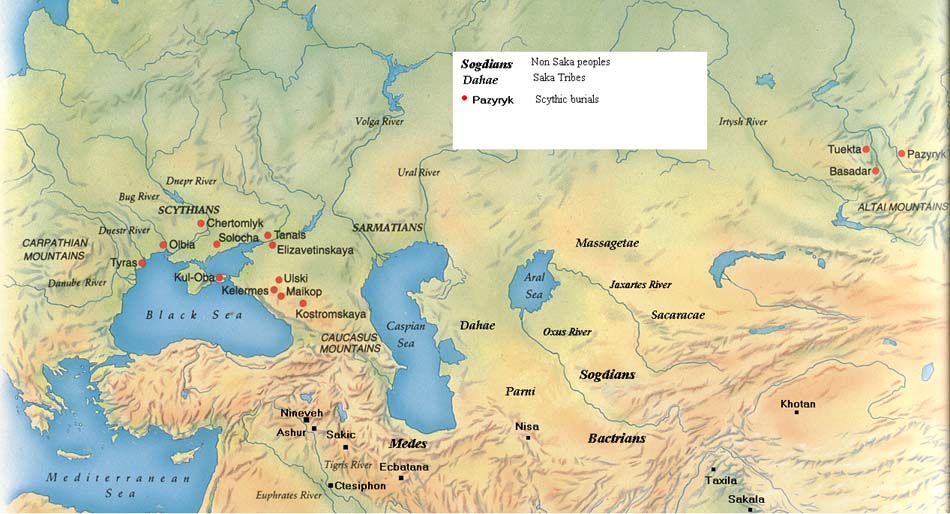
archive also available
| Chicago Coin Club | |
|---|---|
| Volume 46 No. 8 | August 2000 |
This issue is late and small because there are only ten days from when I returned from my July vacation and when I leave for ANA Anniversary Convention in Philadelphia. Please be warned: I will ask all local club members who I see there, to submit their impressions of the meetings and lectures they attended, along with any interesting tales from their trips.
Paul Hybert, editor
The 978th meeting of the Chicago Coin Club was called to order at 7:05 PM on July 12 by president Carl Wolf. Minutes from prior meeting were corrected to state that there was a second reading for Sharon and Kevin Blocker and they then became members at the June meeting. There was a second reading for M. Michael Williams and he became a member at the July meeting. Guest and featured speaker for the evening was Kevin Dailey.
Kevin Dailey hosted an evening of Numismatic Jeopardy. Club members were divided into four teams of four each and competed in such categories as British coins, denominations, and "Begin L". In the end, team #1, comprised of Denise Kitchen, Don Dool, Joe Tomasko, and Richard Hamilton, emerged victorious with 410 points. Team #3 was a close second with 390 points followed by teams 4 and 2. The members of the winning team were each presented a token of Saint Eligius, the patron saint of coin collecting.
Exhibitors for the evening were as follows:
Under old business, the recent Mid-America Coin and Collectibles Show was mentioned with several criticisms.
For new business, Don Dool spoke about the Veteran Coin & Stamp Club by Phoenix AZ; Jeff Rosinia will look into what the design will be for the Illinois state quarter; and Mark Wieclaw solicited opinions on legality of owning 1937 Philipine coin dies.
Meeting adjourned at 8:58 PM.
Respectfully Submitted,
Richard Hamilton
Secretary-Treasurer
by Robert Weinstein
(Presented at the June 14 meeting.)
The term Saka is used to denote the Scythic peoples dwelling on the steppe from the Caspian Sea east to the borders of China.These people were nomads and were famous in antiquity for their horsemanship and fearlessness in battle. The Sakas of Central Asia and the Scythians of the Black Sea region are descended from an earlier culture which dwelt in the Altai. The Sakas and Scythians spoke Iranian languages which were related to those of the Persians, Medes, Bactrians, and Sogdians.

The Scythians first enter history in the 8th century B.C.E. . Their home was the area North of the Black Sea.From there they would traverse the passes of the Caucasus Mountains to raid the rich kingdoms of Mesopotamia and Anatolia. They are mentioned several times in the bible.The records of the Assyrian and Persian Kingdoms mention them frequently.According to Herodotus the Persians used the word Saka for all Scythian nomads.This is because that is what they called themselves and the name translates directly into the Persian language which was related to the language of the Sakas.The Black Sea Scythians called themselves Saka in the 7th century B.C.E. but, by the time Herodotus wrote his history they seem not to use this name for themselves. The name Scythian is the Latinised version of Skythian which is what they were called by the Greeks. One of their kings, a man named Partatua, asked for the Assyrian King Asarhaddon's daughter in marriage. This dynastic alliance benifitted the crumbling Assyrian Empire on several occasions most notably when the Scythian King Madys, the son of Partatua, came to the aid of the the Assyrian capital of Nineveh which was besieged by the Medes. Madys may have been the nephew of the Assyrian King Assurbanipal. Herodotus tells us that after the destruction of the Medes at Nineveh the Scythians controlled the near east for 28 years. Their capital was at Sakic. Their raids reached as far as Egypt. Their power was finally broken by a resurgence of Median power. According to Herodotus this was accomplished by inviting their leaders to a feast and making them so drunk that they passed out. The Median King Cyaraxes then had them all murdered. After the loss of their leaders the Scythians abandoned Asia and retreated across the Caucasus mountains back to the Crimean Penninsula where they remained.
The Scythian Kings struck an extensive series of coins. All are scarce. Most of the kings named on the coins are unknown to history. King Ateas is an exception. He is well documented in the historical record. Unfortunatly his coins are very rare. Ateas took to the field of battle against Philip II of Macedon at the age of 90. Ateas lost the battle and was killed but Philip learned what the Persians had learned on an earlier occasion, the Scythians were not easily conquered. Philip was eventually forced to withdraw.

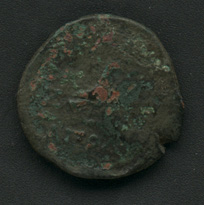
Coin of the Scythian King Kanites AE23 O: Head of Zeus R. CM male head R. wearing Bashlyk R: Eagle ? KANI
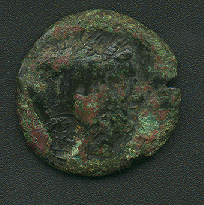
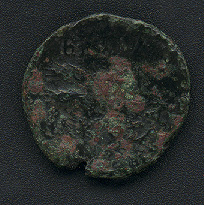
Coin of the Scythian King Akrosandros AE23 O: Jugate heads of Demeter and Persephone R. CM head of Great God of Odessos? R. R: 2 grain ears BASIL.....AKROS
The Dahae were a confederation of Saka tribes who dwelt between the Caspian Sea and the Oxus river. The Dahae are listed in the great army of the Persian King Xerxes. They later appear as allies of Alexander the Great. The Dahae issued coinage from about 330 B.C.E. to 1 B.C.E. . Most of this coinage is scarce with only the later issues appearing on the market with any frequency. The first coins are anepigraphic copies of Macedonian types. Later copies of Seleucid coinage appear bearing the names of kings and the title of King of the Sakas or King of the Dahae in Aramaic script.These were struck between 250-130 B.C.E. . The final coins of the Dahae were struck from 130 B.C.E. until about 1 B.C.E. . These coins bear Greek legends with the tribal name Kodoy (KwDoU), which is considered to be the same as the earlier Aramaic Gavasa, on the obverse. The reverse bears the legend Atara Saka (ARDHQROU SAKAROU). This type was struck for more than 100 yrs. with the Greek legends becoming corrupt in the successive issues. The style shows considerable degradation as well. Pictured below are three coins of the Atara Saka type showing the degradation of the design.

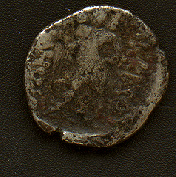
Early type with proper Greek legends
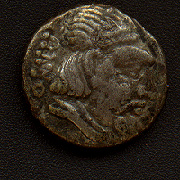
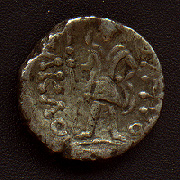
Middle phase with slightly degraded style and corrupt legends
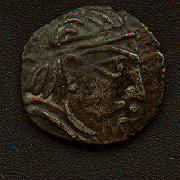
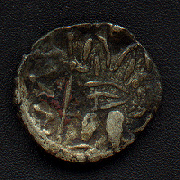
Late type with more degraded style
In the 3rd century B.C.E. the Parni, a tribe of the Dahae confederation, occupied the old Achaemenid satrapy of Parthia. This territory passed to the Seleucid Empire after the death of Alexander the Great. The Parni King Arsakes declared himself independent in 248 B.C.E. and thus was born one of the greatest empires of the ancient world. Arsakes established his capital at Nisa and struck coinage in his name at this city. Arsakes II was forced to submit to Seleucid authority in 209 B.C.E. after the eastern campaign of Antiochus III. After the disasterous military defeat by the Romans, the Seleucid power weakened and the Parthians were independent again. Under Mithradites II the Parthians conquered most of the Seleucid empire. Parthia remained a major world power until 228 C.E. . Most of our current knowledge of the Parthians comes from Greek and Roman historians. There is underway a project to translate Parthian royal documents written in Akkadian, the traditional language of state in the ancient middle east. This should give us more insight into this great empire about which little of the inner workings are known. For nearly 500 yrs. a handful of nomads held together a very large empire with a diverse population. They rarely interacted with their subjects. The nobility was in a state of near constant civil war. There were often 2 or more persons claiming to be king. Eventually they were overthrown by a Persian dynasty in 228 C.E.
All of the early coinage bears the name of Arsakes. The portraits at this time are quite good so that is an aid identifying the coins. The titles on the early coins also differ from king to king. The die engravers were Greeks and the coinage bears Greek legends. Later as the Greek population dwindled and die cutting was taken over by Parthians, the style becomes more abstract and the legends, having been copied from old coins by men who could not read Greek, become corrupt. The late Parthian coinage bears the name of the king in Aramaic script in the Parthian language. Many Parthian coins are dated. Tetradrachms often have both the year and month of manufacture. Below are some Parthian coins.
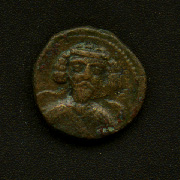
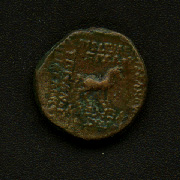
Phraates III 70-57 B.C.E.
AE17
Finer Early Style
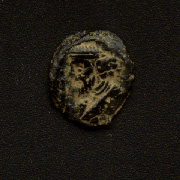
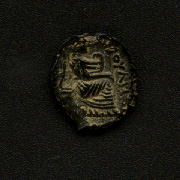
Vardanes I 40-45 B.C.E.
AE Dichalkon
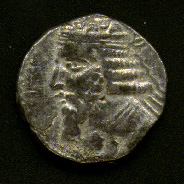
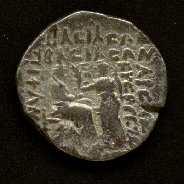
Artabanos II 10-38 C.E.
AR Tetradrachm
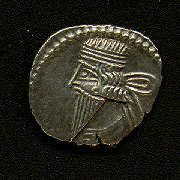
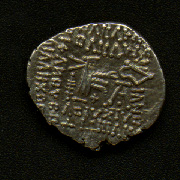
Vologases III 105-147 C.E.
AR Drachm
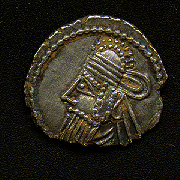
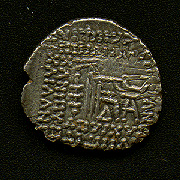
Vologases IV 147-191 C.E.
AR Drachm
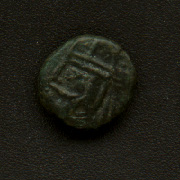
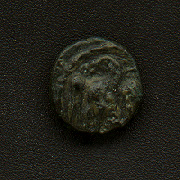
Osroes II 190 C.E.
AE Chalcon
Sometime around 130 B.C.E. another nomadic people known as the Yueh Chi were driven out of Kansu in China by a Turkish tribe called the Wu Sun. This movement set in motion the various steppe nomads displacing them into other lands. The Sacaraucae confederation was pushed West of the Jaxartes river into Sogdiana and Bactria. According to Chinese annals part of the Sacaraucae went South into Khotan. It is probable that Khotan had already long been occupied by Sakas. Much of our information about the Saka kingdoms in India comes from their coins. The chronology and genealogy have long been in debate and this continues today. The work of R.C. Senior and others is challenging the old ideas of who were Greek Kings and who were Sakas. The Senior collection of Indo-Scythian coinage numbered more than 3000 pieces. Many of the coins are unique. This collection now resides in the Ashmolean Museum. A catalog of the collection is in production. Among the enlightening coins in this collection is a coin of the king Artemidoros which proclaims him as the son of the Saka Maues. Artemidoros has traditionally been listed as a Greek king.
The Sakas established several kingdoms in India. One of the first was the kingdom founded by Vonones in what is today parts of Afghanistan and Northern Pakistan. Vonones associated his brother, Spalahores, as Viceroy and struck coins bearing both of their names. Spalagadames followed his father Spalahores as Viceroy on the latters death. Later Vonones associated his other brother Spalarises as heir apparent. Spalarises ascended the throne on Vonones death.
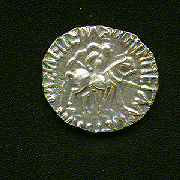
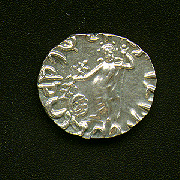
Vonones with Spalagadames
90-65 B.C.E.
O:
King on horseback with spear
Greek legend
naming Vonones as king
BASILEWS
BASILEWN MEGALOU ONWNOU
R:
Zeus holding thunderbolt and scepter
Kharosthi legend naming
Spalagadames as Viceroy
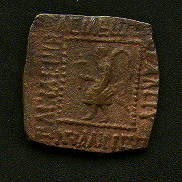
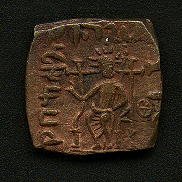
Spalarises as king
65-40 B.C.E.
O:
King R. carring ankus
Greek legend naming Spalarises as king
BASILEWS
MEGALOU PALIRISOU
R:
Zeus enthroned
Kharosthi legend naming
Spalarises as king
Shortly after the founding of Vonones' kingdom, another Saka, named Maues, founded a kingdom to the south of Vonones. Maues successor, Azes the Great, absorbed the neighboring kingdom ruled by Spalarises. There was a brief joint coinage bearing the names of both Azes and Spalarises and then Azes became sole ruler. Azes ascended the throne in 58 B.C.E. and ruled for many years. His successor was Azilises. There is a series of joint Azes/Azilises coinage which preceeds the coinage in Azilises name alone. Traditionally the successor to Azilises has been considered to be another king named Azes but, this view has lately been challenged by R.C. Senior who believes that all of the coinage in the name of Azes was struck by one king by that name. The silver coinage in the name of Azes occurs in two main types. The first attributed to Azes I depicts the king on horseback with spear. The second attributed to Azes II depicts the king on horseback holding a whip.
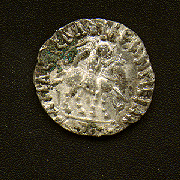
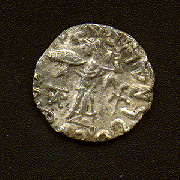
Azes on horseback with spear
AR Drachm
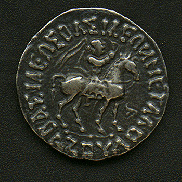
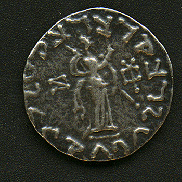
Azes on horseback with whip
AR Tetradrachm
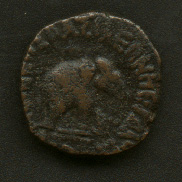
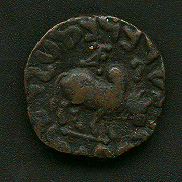
AE hexachalkon of Azes
O: Elephant R., Greek legend
R: Bull R., Kharosthi legend
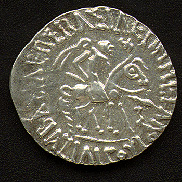
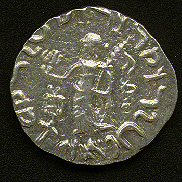
AR Tetradrachm of Azilises
O: king on horseback with spear
R: City goddess L., Kharosthi legend
Most of the coins of those who came after Azilises are all quite scarce and rarely offered for sale. The exception are the coins previously classified as posthumous coinage in the name of Azes. These coins usually have corrupt Greek legends and poor style. The later ones are very debased billon. The Kharosthi legends remain readable and name Azes as king. In ONS newsletter #156 R.C. Senior proposes that these coins were stuck by the early Apracharajas and demonstrates how the series leads to the coinage bearing the names of the later Apracharajas. The first Apracharaja, Vijayamitra, probably ruled from 20 B.C.E. to 19/20 C.E. . This very long reign of Vijayamitra accounts for the large number of coins of this type which have been found.
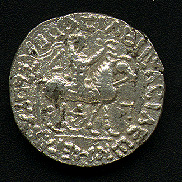
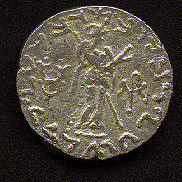
First series of coinage of Vijayamitra
O: King on horseback with whip
Corrupt Greek legend (AZZOU)
Heart at 2 o'clock in legend indicating
B officina
R: Pallas R. with spear, Kharosthi legend naming Azes
The Sacaraucae in eastern Iran came under the influence of the Parthians around 80 B.C.E. when Sinatruces, a member of the Parthian royal family, sought asylum among them. With the help of the Sakas Sinatruces obtained the Parthian throne and the Sacaraucae became Parthian vassals. Their earliest coinage imitates contemporary Parthian coinage. These coins do not bear a rulers name. The first ruler to put his name on his coinage was Tanlis. He issued coins bearing both his name and the name Lady Raggodeme. It was long believed that his successor was named Otannes but, coins formerly attributed to this king are now known to also be the work of Tanles. The Otannes coins were countermarked Parthian drachms. The countermark bore a name which had long been misread. What had been read as an O turned out to be a decorative ball on a cap worn by the person pictured. Tanles had several successor but, none put there names on their coinage. All of the coins issued by the kings who followed Tanles are copies of Parthian drachms with the curious feature of having a countermark engraved on the die.
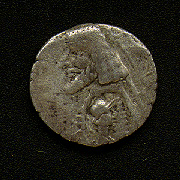
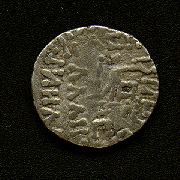
Sacaraucae drachm of King "A" 40 B.C.E.
The last of the Sacaraucan coins bear the Tamgha which is referred to as the Gondopharan symbol. These coins show that the Indo-Parthian kingdom of Gondophares evolved from the earlier Sacaraucan kingdom. Gondophares the Great eventually conquered all of lands once held by the Indo-Greeks and all of the rival Saka kingdoms in India. He had long been considered to be the king mentioned in the Acts of the Apostle Thomas. A revised chronology of the Sakas in India makes his reign far too early for him to be the King of the Indians that Thomas preached to. A later king, Gondophares-Sases, is a more likely candidate for the person. The Indo-Parthian kingdom lasted into the 3rd century C.E. . At that time the kingdom split into Sakastan and Turan. These two kingdoms later became vassals of the Sassanid Persians who overthrew the Parthians.
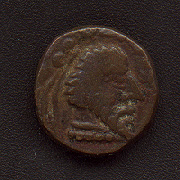
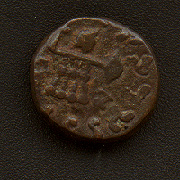
Gondophares AE Drachm
O: Bust R.
R: Pallas R., Kharosthi legend
Kings name spelled Gudapharasa
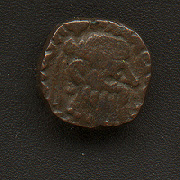
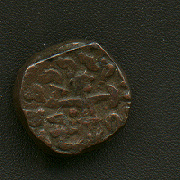
Gondophares AE Drachm
O: Bust R. Corrupt Greek legend
R: Pallas R., Kharosthi legend
Kings name spelled Gadavirasa
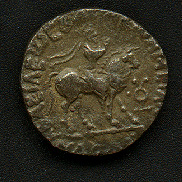

Gondopares Billon Tetradrachm
O: King on horseback, Gondopharan symbol before, Greek
legends
R: Zeus standing R., control marks before and behind, Kharosthi legends


Sases AE Drachm
O: King on horseback, Gondopharan symbol before, Greek
legends
R: Zeus standing R., control marks before and behind, Kharosthi legends
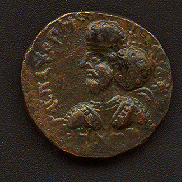
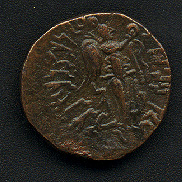
Pakores AE tetradrachm
O: Bust of king L., Greek legend
R: Nike R., Kharosthi legend
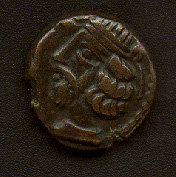
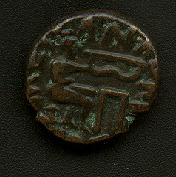
Sanabares II AE Drachm
O: Bust L.
R: Seated archer, Greek legend
| Date: | August 9, 2000 |
| Time: | 7:00 PM |
| Location: | Bank One Plaza Building (formerly the First National Bank Building) 18th Floor, on Dearborn between Madison and Monroe. Enter the building at the South entrance of the Dearborn side, sign in at the security desk and take the elevator to the 18th floor. |
| Featured Program: | Saul Needleman - Elongated Cents of the Century of Progress |
| Review some local history with us as we remember the World's Fair held in Chicago in 1933, which was the one-hundredth anniversary of the founding of Chicago. |
| Aug | 9 | CCC Meeting - no Featured Speaker yet |
| Aug | 9-13 | ANA convention in Philadelphia - at least 5 local members going |
| Sep | 13 | CCC Meeting - Featured Speaker - Cliff Priest on Chicagoland Stock Certificates. |
| September | 1 | Fred K. White | 1991 |
| September | 2 | John Wilson | 1984 |
| September | 7 | James M. McMenamin | 1975 |
| September | 18 | Michael M. Dolnick | 1952 |
| September | 18 | Gregory Gajda | 1999 |
| September | 19 | Russell F. Wajda | 2000 |
| September | 21 | Kerry K. Wetterstrom | 1999 |
| September | 24 | Michael A. Pesha | 1979 |
| September | 25 | Saul Needleman | 1992 |
| September | 26 | Dennis P. Ciechna | 1999 |
| September | 27 | Edward Stevens | 1996 |
| September | 29 | Gordon R. Donnell | 1999 |
| September | 29 | Thomas Kulasik | 1996 |
| Paul Hybert
ECE Dept, IIT 3301 S. Dearborn Chicago, IL 60616 |
| prh@ece.iit.edu |
| 1-312-567-3976 |
| Carl Wolf | - President |
| Steven Zitowsky | - First Vice President |
| Robert Feiler | - Second Vice President |
| Directors: | Paul Hybert
Mike Metras Jeff Rosinia Mark Wieclaw |
| Other positions held are: | |
| Richard Hamilton | - Secretary Treasurer |
| Paul Hybert | - Chatter Editor |
| Phil Carrigan | - Archivist |